A Family of Fifth and Sixth Convergence Order Methods for Nonlinear Models
Abstract
1. Introduction
2. Convergence
- () is differentiable, , and is a simple solution of (1).
- () for all .Set .
- () , and for all .
- () , where r is given in (11).
- () There exist such thatSet .
3. Dynamical Analysis of the Discussed Class of Algorithms (3)
- (i)
- superattractor if ,
- (ii)
- attractor if ,
- (iii)
- repulsor if and
- (iv)
- parabolic if .
3.1. Stability of the Fixed Points
- 1.
- is a superattracting strange fixed point for .
- 2.
- is an attracting point if .
- 3.
- For the point is parabolic.
- 4.
- Lastly, if , then is repulsor.
3.2. Study of Parameter Spaces and Critical Points
4. Numerical Examples
Author Contributions
Funding
Institutional Review Board Statement
Informed Consent Statement
Data Availability Statement
Conflicts of Interest
References
- Argyros, I.K. Convergence and Application of Newton-type Iterations; Springer: Berlin/Heidelberg, Germany, 2008. [Google Scholar]
- Argyros, I.K.; Cho, Y.J.; Hilout, S. Numerical Methods for Equations and Its Applications; Taylor & Francis, CRC Press: New York, NY, USA, 2012. [Google Scholar]
- Behl, R.; Martínez, E. A New Higher-Order and Efficient Family of Iterative Techniques for Nonlinear Models. Complexity 2020, 2020, 1706841. [Google Scholar] [CrossRef]
- Cordero, A.; Hueso, J.L.; Martínez, E.; Torregrosa, J.R. A modified Newton-Jarratt’s composition. Numer. Algor. 2010, 55, 87–99. [Google Scholar] [CrossRef]
- Cordero, A.; García-Maimó, J.; Torregrosa, J.R.; Vassileva, M.P. Solving nonlinear problems by Ostrowski-Chun type parametric families. J. Math. Chem. 2014, 53, 430–449. [Google Scholar] [CrossRef]
- Ezquerro, J.; Hernández, M.A. On Halley-type iteration with free second derivative. J. Comput. Appl. Math. 2004, 170, 455–459. [Google Scholar] [CrossRef][Green Version]
- Ezquerro, J.A.; González, D.; Hernández, M.A. Majorizing sequences for Newton’s method from initial value problems. J. Comput. Appl. Math. 2012, 236, 2246–2258. [Google Scholar] [CrossRef]
- Grau-sánchez, M.; Noguera, M.; Amat, S. On the approximation of derivatives using divided difference operators preserving the local convergence order of iterative methods. J. Comput. Appl. Math. 2013, 237, 363–372. [Google Scholar] [CrossRef]
- Kou, J.; Li, Y.; Wang, X. A composite fourth-order iterative method for solving nonlinear equations. Appl. Math. Comput. 2007, 184, 471–475. [Google Scholar] [CrossRef]
- Iliev, A.; Kyurkchiev, N. Nontrivial Methods in Numerical Analysis: Selected Topics in Numerical Analysis; LAP LAMBERT Academic Publishing: Chișinău, Moldova, 2010. [Google Scholar]
- Neta, B.; Scott, M.; Chun, C. Basins of attraction for several methods to find simple roots of nonlinear equations. Appl. Math. Comput. 2012, 218, 10548–10556. [Google Scholar] [CrossRef]
- Petković, M.S.; Neta, B.; Petković, L.; Džunić, D. Multipoint Methods for Solving Nonlinear Equations; Elsevier: Amsterdam, The Netherlands, 2013. [Google Scholar]
- Rall, L.B. Computational Solution of Nonlinear Operator Equations; Robert E. Krieger: New York, NY, USA, 1979. [Google Scholar]
- Sharma, J.R. A composite third order Newton-Steffensen method for solving nonlinear equations. Appl. Math. Comput. 2005, 169, 242–246. [Google Scholar] [CrossRef]
- Sharma, J.R.; Guna, R.K.; Sharma, R. An efficient fourth order weighted-Newton method for systems of nonlinear equations. Numer. Algor. 2013, 62, 307–323. [Google Scholar] [CrossRef]
- Traub, J.F. Iterative Methods Solut. Equations; Prentice-Hall: Englewood Cliffs, NJ, USA, 1964. [Google Scholar]
- Amat, S.; Argyros, I.K.; Busquier, S.; Hernández-Verón, M.A.; Martínez, E. On the local convergence study for an efficient k-step iterative method. J. Comput. Appl. Math. 2018, 343, 753–761. [Google Scholar] [CrossRef]
- Argyros, I.K.; Magreñán, Á.A. On the convergence of an optimal fourth-order family of methods and its dynamics. Appl. Math. Comput. 2015, 252, 336–346. [Google Scholar] [CrossRef]
- Argyros, I.K.; Magreñán, Á.A. A study on the local convergence and the dynamics of Chebyshev-Halley-type methods free from second derivative. Numer. Algor. 2015, 71, 1–23. [Google Scholar] [CrossRef]
- Argyros, I.K.; Cho, Y.J.; George, S. Local convergence for some third order iterative methods under weak conditions. J. Korean Math. Soc. 2016, 53, 781–793. [Google Scholar] [CrossRef]
- Argyros, I.K.; George, S. Local convergence for an almost sixth order method for solving equations under weak conditions. SeMA J. 2017, 75, 163–171. [Google Scholar] [CrossRef]
- Argyros, I.K.; Sharma, D.; Parhi, S.K. On the local convergence of Weerakoon-Fernando method with ω continuity condition in Banach spaces. SeMA J. 2020, 77, 291–304. [Google Scholar] [CrossRef]
- Argyros, I.K.; George, S. On the complexity of extending the convergence region for Traub’s method. J. Complex. 2020, 56, 101423. [Google Scholar] [CrossRef]
- Maroju, P.; Magreñán, Á.A.; Sarría, Í.; Kumar, A. Local convergence of fourth and fifth order parametric family of iterative methods in Banach spaces. J. Math. Chem. 2020, 58, 686–705. [Google Scholar] [CrossRef]
- Regmi, S.; Argyros, I.K.; George, S. Direct comparison between two third convergence order schemes for solving equations. J. Symmetry 2020, 12, 1080. [Google Scholar] [CrossRef]
- Sharma, D.; Parhi, S.K. Local Convergence and Complex Dynamics of a Uni-parametric Family of Iterative Schemes. Int. J. Appl. Comput. Math. 2020, 6, 83. [Google Scholar] [CrossRef]
- Singh, S.; Gupta, D.K.; Badoni, R.P.; Martínez, E.; Hueso, J.L. Local convergence of a parameter based iteration with Hölder continuous derivative in Banach spaces. Calcolo 2017, 54, 527–539. [Google Scholar] [CrossRef]
- Argyros, I.K.; George, S. Extending the Applicability of a Seventh Order Method Without Inverses of Derivatives Under Weak Conditions. Int. J. Appl. Comput. Math. 2019, 6, 4. [Google Scholar] [CrossRef]
- Amat, S.; Busquier, S.; Plaza, S. Review of some iterative root-finding methods from a dynamical point of view. Sci. Ser. A Math. Sci. 2004, 10, 3–35. [Google Scholar]
- Amat, S.; Busquier, S.; Plaza, S. Dynamics of the King and Jarratt iterations. Aequationes Math. 2005, 69, 212–223. [Google Scholar] [CrossRef]
- Cordero, A.; Torregrosa, J.R.; Vindel, P. Dynamics of a family of Chebyshev-Halley type methods. Appl. Math. Comput. 2013, 219, 8568–8583. [Google Scholar] [CrossRef]
- Cordero, A.; Guasp, L.; Torregrosa, J.R. Choosing the most stable members of Kou’s family of iterative methods. J. Comput. Appl. Math. 2018, 330, 759–769. [Google Scholar] [CrossRef]
- Cordero, A.; Villalba, E.G.; Torregrosa, J.R.; Triguero-Navarro, P. Convergence and Stability of a Parametric Class of Iterative Schemes for Solving Nonlinear Systems. Mathematics 2021, 9, 86. [Google Scholar] [CrossRef]
- Chicharro, F.; Cordero, A.; Torregrosa, J.R. Drawing dynamical and parameters planes of iterative families and methods. Sci. World J. 2013, 2013, 780153. [Google Scholar] [CrossRef]
- Kumar, D.; Sharma, J.R.; Jäntschi, L. Convergence Analysis and Complex Geometry of an Efficient Derivative-Free Iterative Method. Mathematics 2019, 7, 919. [Google Scholar] [CrossRef]
- Magreñán, Á.A. Different anomalies in a Jarratt family of iterative root-finding methods. Appl. Math. Comput. 2014, 233, 29–38. [Google Scholar] [CrossRef]
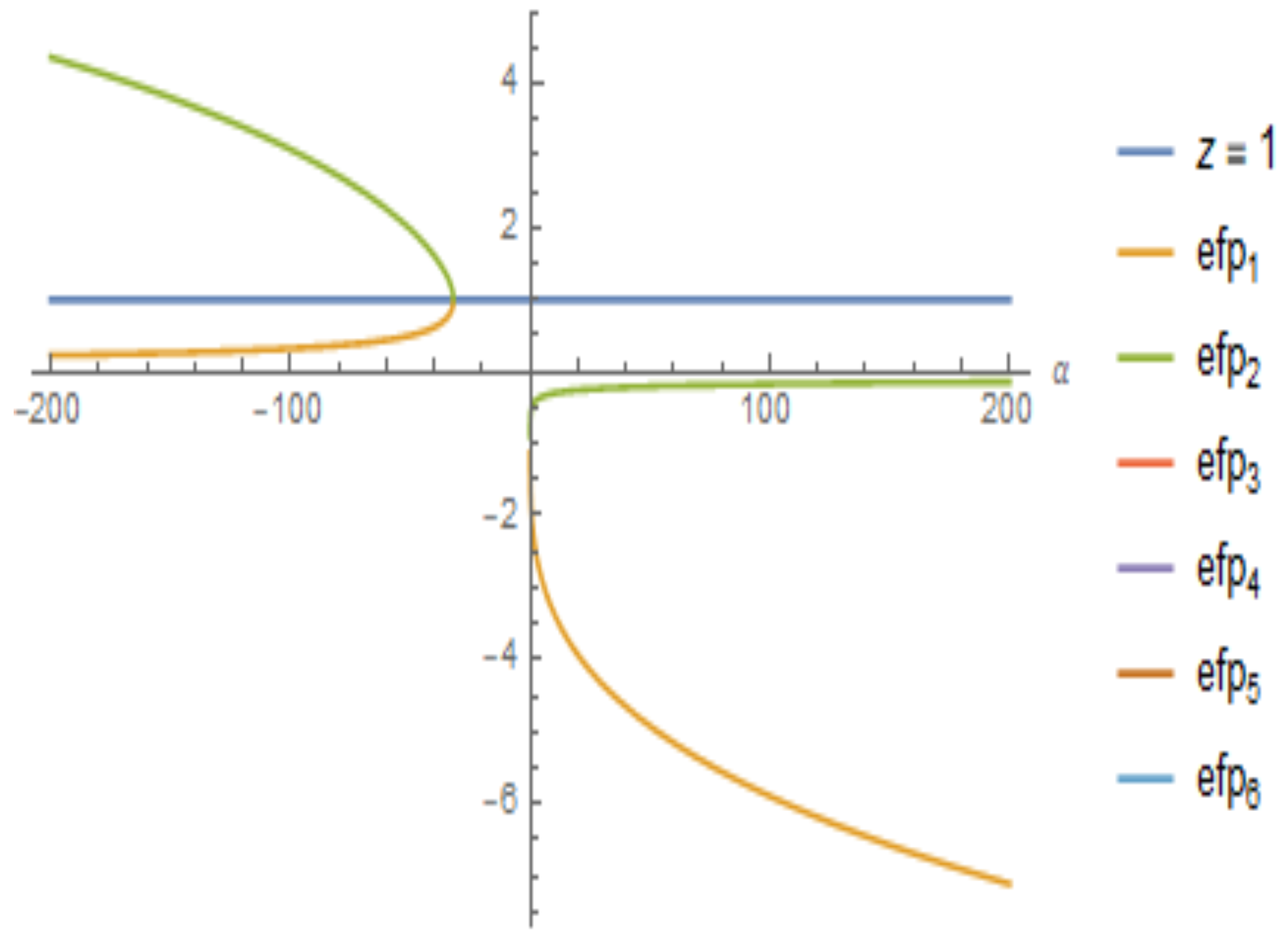

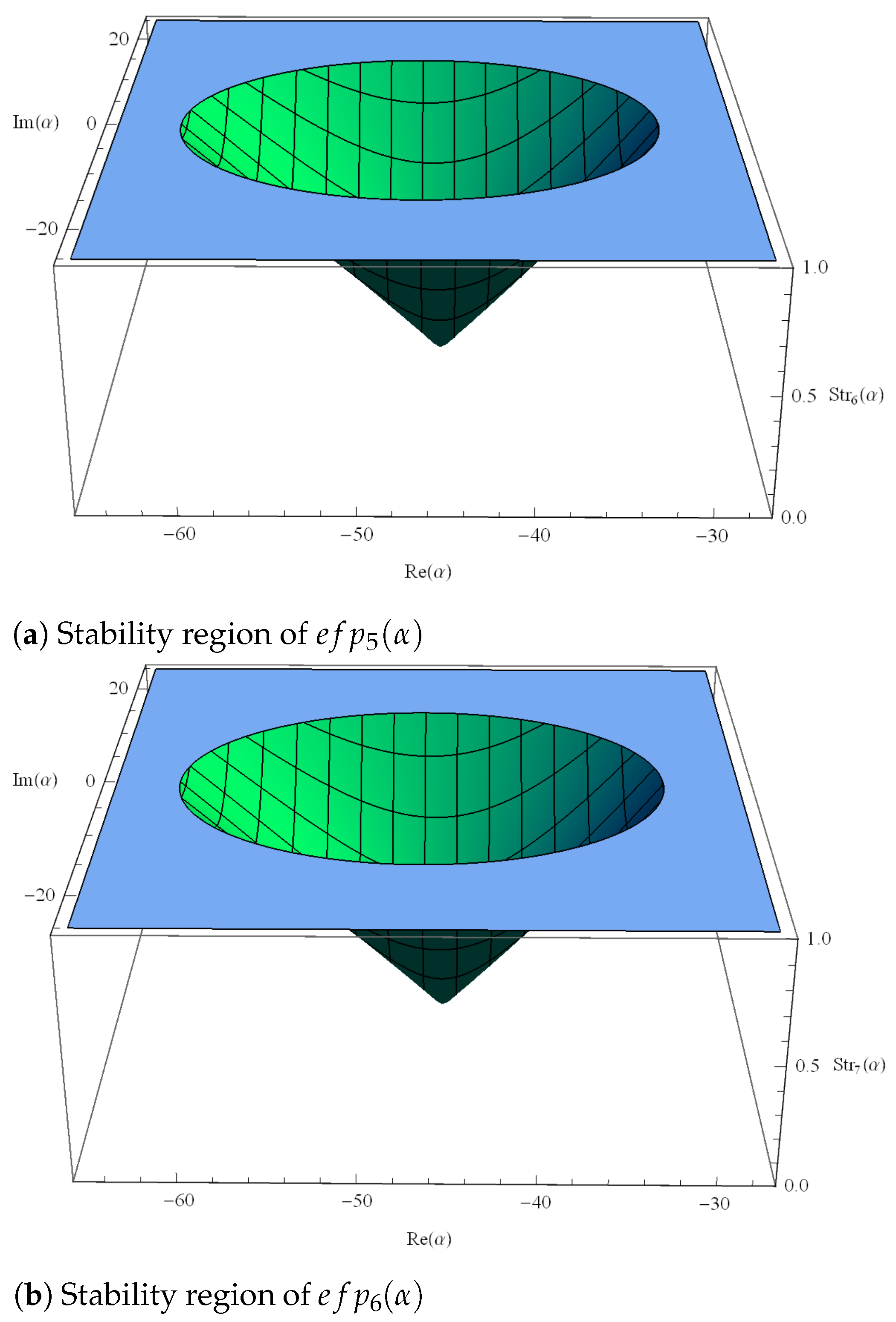

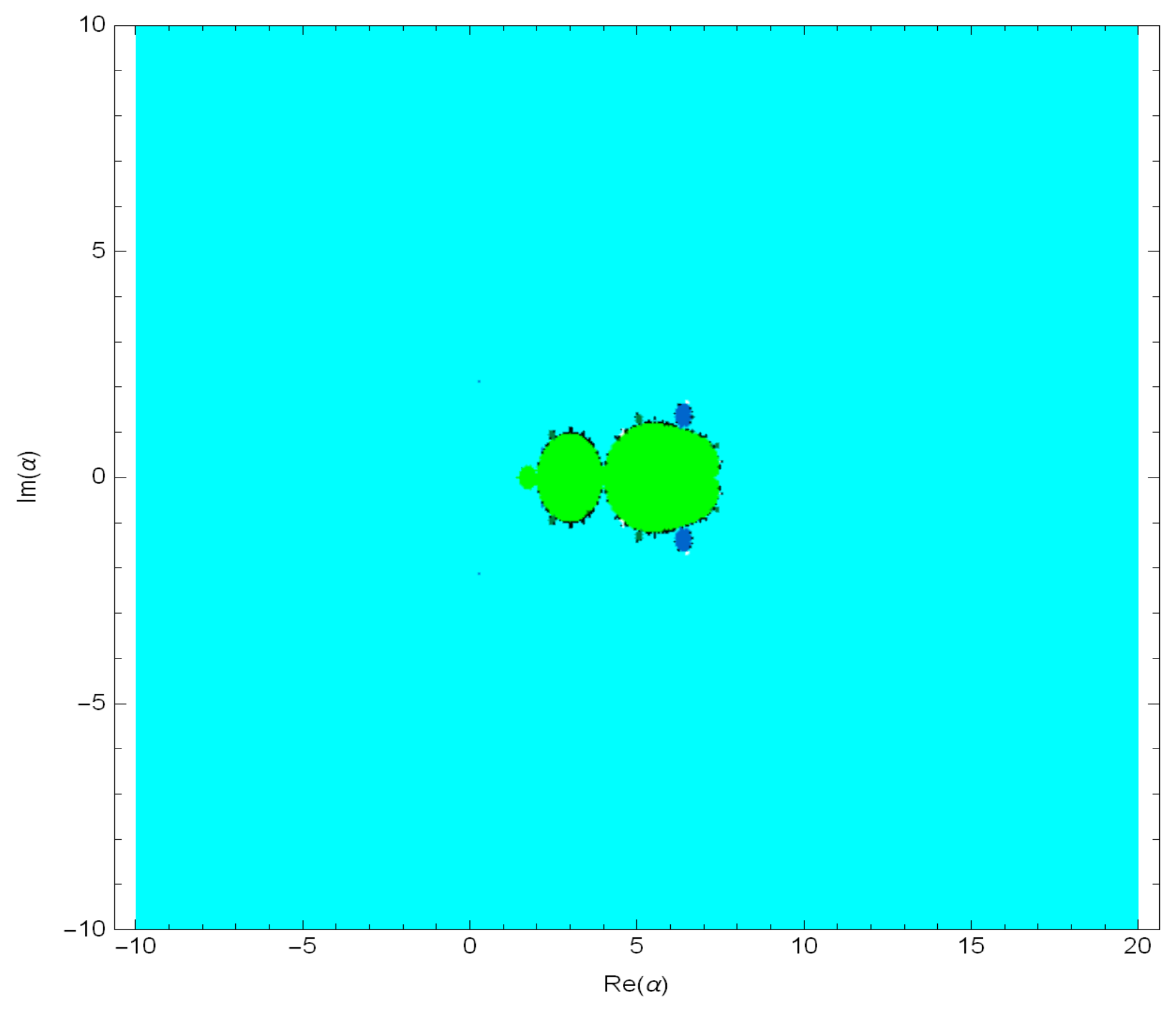



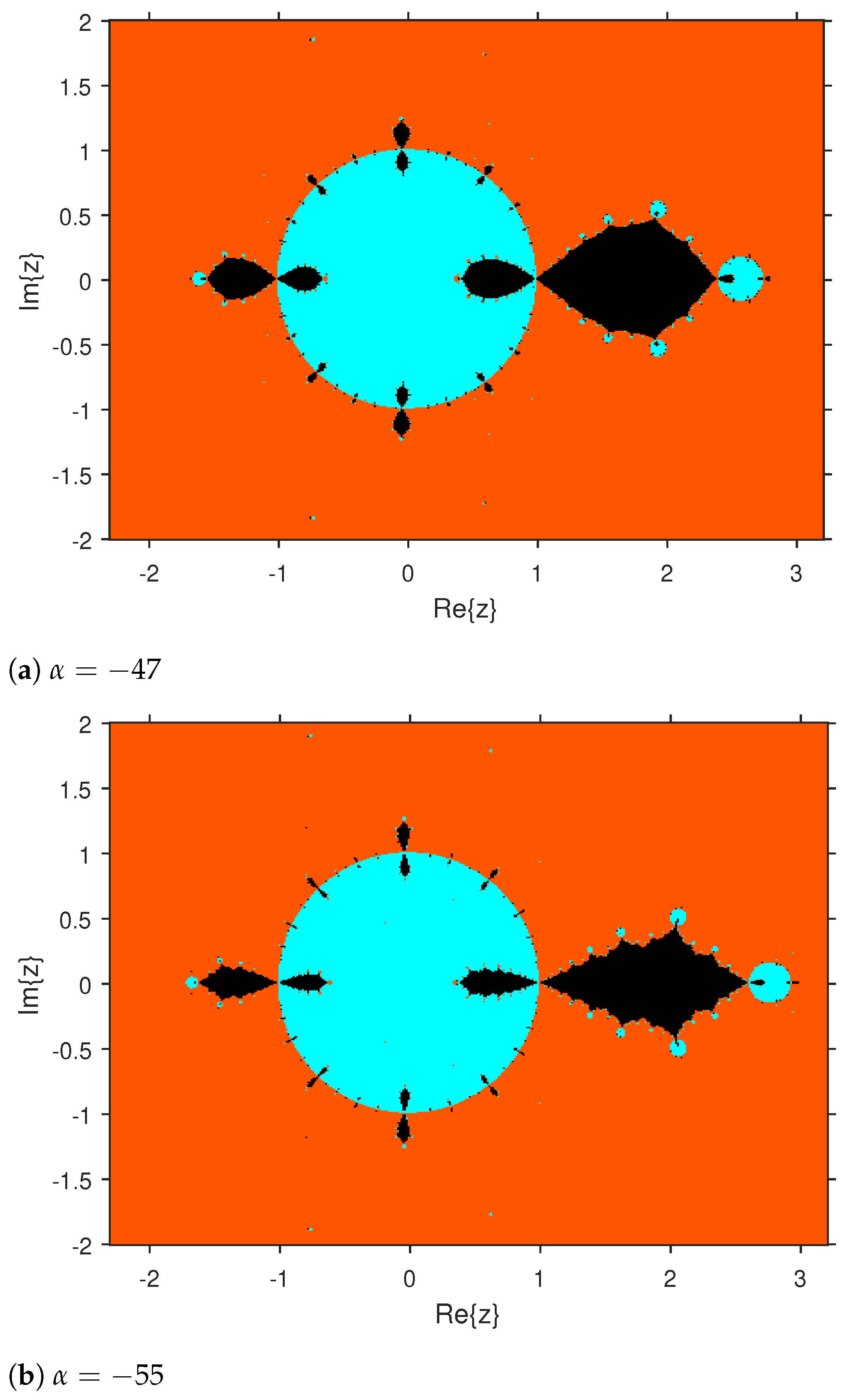


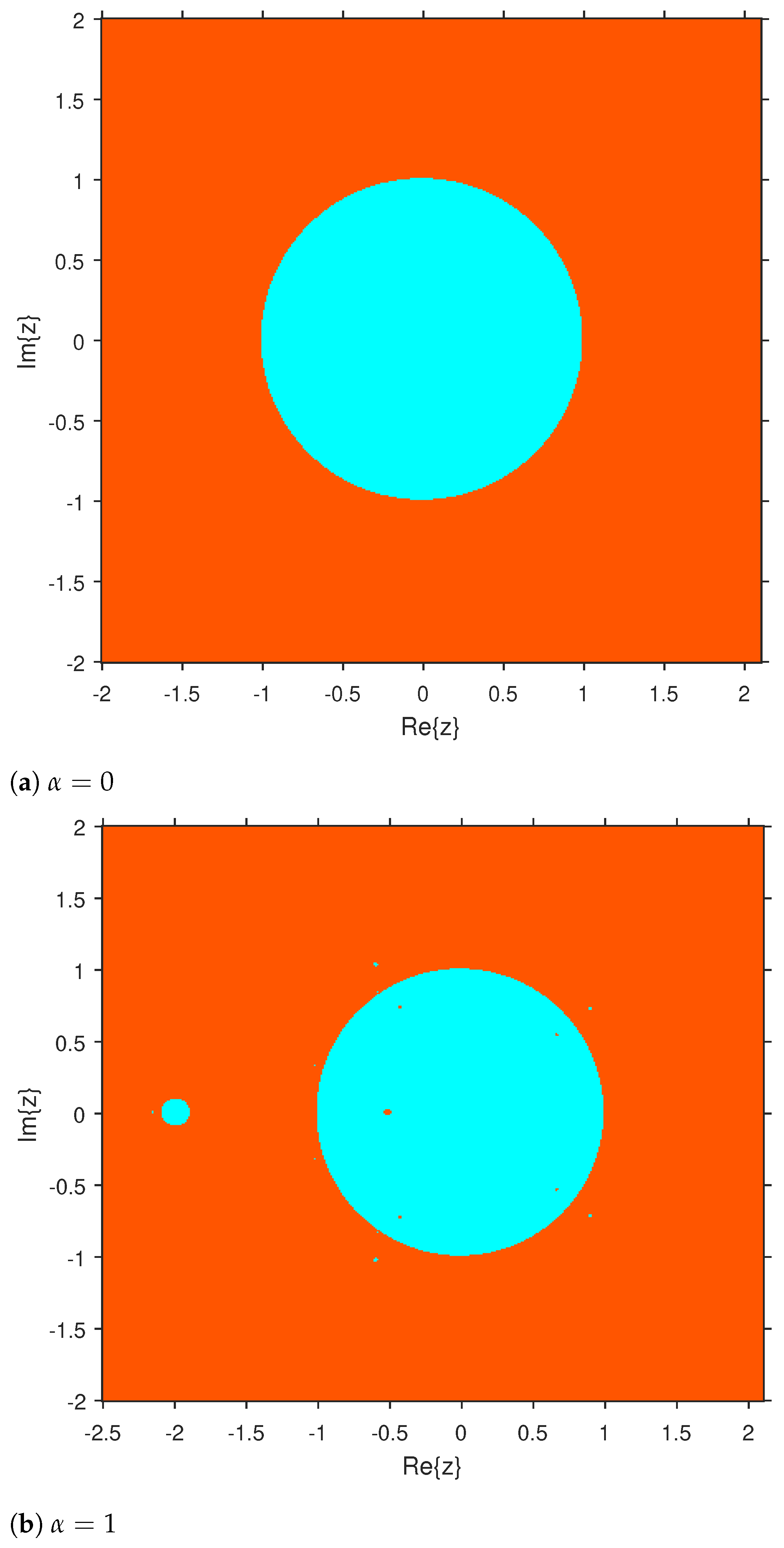
Publisher’s Note: MDPI stays neutral with regard to jurisdictional claims in published maps and institutional affiliations. |
© 2021 by the authors. Licensee MDPI, Basel, Switzerland. This article is an open access article distributed under the terms and conditions of the Creative Commons Attribution (CC BY) license (https://creativecommons.org/licenses/by/4.0/).
Share and Cite
Argyros, I.K.; Sharma, D.; Argyros, C.I.; Parhi, S.K.; Sunanda, S.K. A Family of Fifth and Sixth Convergence Order Methods for Nonlinear Models. Symmetry 2021, 13, 715. https://doi.org/10.3390/sym13040715
Argyros IK, Sharma D, Argyros CI, Parhi SK, Sunanda SK. A Family of Fifth and Sixth Convergence Order Methods for Nonlinear Models. Symmetry. 2021; 13(4):715. https://doi.org/10.3390/sym13040715
Chicago/Turabian StyleArgyros, Ioannis K., Debasis Sharma, Christopher I. Argyros, Sanjaya Kumar Parhi, and Shanta Kumari Sunanda. 2021. "A Family of Fifth and Sixth Convergence Order Methods for Nonlinear Models" Symmetry 13, no. 4: 715. https://doi.org/10.3390/sym13040715
APA StyleArgyros, I. K., Sharma, D., Argyros, C. I., Parhi, S. K., & Sunanda, S. K. (2021). A Family of Fifth and Sixth Convergence Order Methods for Nonlinear Models. Symmetry, 13(4), 715. https://doi.org/10.3390/sym13040715







